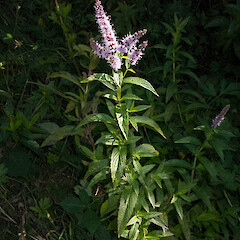Mentha spicata subsp. spicata
Common name
mint
Family
Lamiaceae
Flora category
Vascular – Exotic
Structural class
Herbs - Dicotyledons other than Composites
Conservation status
Not applicable
Wetland plant indicator status rating
Information derived from the revised national wetland plant list prepared to assist councils in delineating and monitoring wetlands (Clarkson et al., 2021 Manaaki Whenua – Landcare Research Contract Report LC3975 for Hawke’s Bay Regional Council). The national plant list categorises plants by the extent to which they are found in wetlands and not ‘drylands’. The indicator status ratings are OBL (obligate wetland), FACW (facultative wetland), FAC (facultative), FACU (facultative upland), and UPL (obligate upland). If you have suggestions for the Wetland Indicator Status Rating, please contact: [Enable JavaScript to view protected content]
FAC: Facultative
Commonly occurs as either a hydrophyte or non-hydrophyte (non-wetlands).
Similar taxa
subsp. spicata: Stems glabrous or sparsely hairy. Leaves with hairs confined to veins on lower surface; lamina rounded to cordate at base. Inflorescences glabrose or sparsely hairy; spikes slender or fairly stout, often interrupted, especially in lower part. Corolla almost glabrose outside. Nutlets present or 0. Two distinct forms of subsp. spicata are naturalised. 1) Lanceolate or narrow-elliptic +/- plane leaves, deciduous in colder areas. 2) Ovate, ovate-oblong or elliptic rugose leaves, evergreen in all parts of the country.
Flower colours
Violet/Purple
Etymology
mentha: Mint



